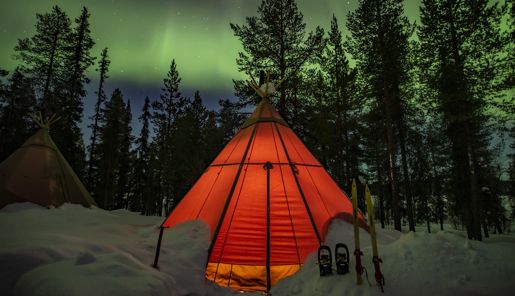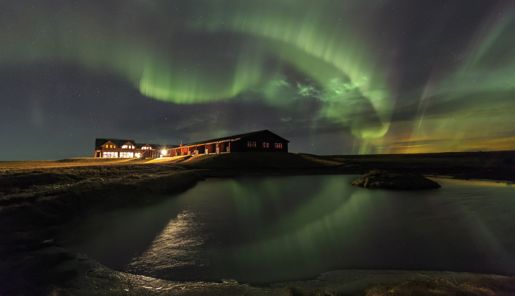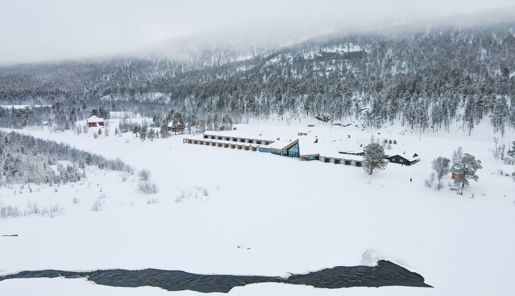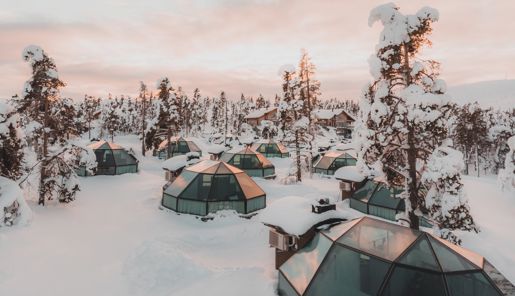Northern Lights Holidays
 Scroll to content
Scroll to content
Witnessing Mother Nature's most famous light show is one of the greatest travel experiences on Earth. Head north, above a latitude of 60° from late September through to late March, and you'll be in prime position for dazzling displays of this remarkable phenomenon. Whether you choose to visit Iceland, Finland, Sweden, or Norway, we can plan the perfect trip designed with aurora hunting in mind.

Northern Lights Holiday Ideas
Below you'll find a selection of our favourite northern lights holiday ideas for inspiration. Although sightings of the ethereal light show can't be guaranteed, our trips have been carefully crafted to maximise your chances of witnessing this magical and mysterious marvel.
-


Day 1 | Arrive in Finnish Lapland

Day 2 | Reindeer Sleigh Ride & Snowmobile Safari

Day 3 | Husky Sled Ride

Day 4 | Ice Karting, Ice Fishing & Cross Country Ski

Day 5 | Departure Day
4 nights
Deluxe Dome Escape at Aurora Village
Stay in an luxurious glass-roof cabin with skyward views. Experience a husky sled ride, snowmobile safari and search for the northern lights from the comfort of your very own bed. -
Aurora Borealis by basiczto


Day 1 | Arrive in Lapland

Day 2 | Snowmobile Adventure

Day 3 | Husky & Reindeer Experience

Day 4 | Ice Fishing & Aurora Snowmobiling

Day 5 | Snowshoe Adventure

Day 6 | Cross Country Ski & Aurora Camp

Day 7 | Departure Day
6 nights
Frozen Fairytale | Romance Under The Aurora
Stay in a glass roof cabin and a luxury log cabin complete with your own private sauna and hot tub at this adult-only retreat in Finnish Lapland. -

Tromsø | Photo by Yngve Olsen for Visit Norway

Day 1 | Arrive in Arctic Norway

Day 2 | City Sightseeing & Cable Car

Day 3 | Journey to Remote Varanger Lodge

Day 4 | Wilderness Safari & Ice Fishing

Day 5 | Dogsledding & Reindeer Sanctuary Visit

Day 6 | King Crab Safari

Day 7 | Departure Day
6 nights
Northern Lights on the Edge of the Arctic
Take in the sights of the vibrant city of Tromsø before heading further north to relax in a beautiful remote lodge in the far north of Arctic Norway.
We craft tailor-made Northern Lights holidays, thoughtfully designed just for you — no two adventures are the same
When & Where to spot the Aurora

The best time to see the Northern Lights
Although the northern lights are active throughout the entire year, it's not possible for us to see them during the light summer months as there are simply not enough hours of darkness. Travel in Autumn to early Spring for the very best chances of seeing the Northern Lights. Most active around the equinoxes in March and September, and most commonly seen between the hours of 9pm and 2am, you can only see them when the sky is clear of cloud.
Revontulet Tykkymaisemassa Thomaskast Mirrorv2

The best places to see the Northern Lights
The aurora is most visible beneath the Northern Lights oval or Aurora Zone, which circles the Earth between a latitude of 60° to 70°. So travel to Finland, Sweden, Norway, or Iceland where there are many locations with low or zero light pollution that afford superb opportunities to witness the incredible natural phenomena. We have carefully selected places, properties, and people to maximise your chances of gaining a glimpse of the bright blazing skies.
Polly Evans | Author | Bradt's Northern Lights Travel Guide BookThe aurora can be seen as undulating ribbons, shimmering curtains, spiky fingers that creep up from the horizon and dazzling rods of colour that burst like a firework

Places to see the Northern Lights

Northern Lights in Finnish Lapland
The Northern Lights are visible on around 200 nights of the year in Finnish Lapland. Choose to stay at the Arctic Treehouse Hotel in the capital, Rovaniemi, or opt for nights spent in a glass-roofed igloo. Situated far enough away from the light pollution of the city, there are many igloo villages in Finnish Lapland that afford magnificent displays of the aurora. Those seeking a winter wonderland should head to the far north of the country for an adventure in Finland's true wilderness.

Northern Lights in Swedish Lapland
In Swedish Lapland, the incredible Treehotel awaits guests who wish to float in a room between pine trees, and ICEHOTEL has rooms carved into works of art and a menu of evening excursions, perfect for aurora hunters. Abisko is home to the world-famous Aurora Sky Station. Lonely Planet reported a trip here to be one of the world's most illuminating experiences; long winter nights and zero light pollution make it the ideal spot for those wishing to catch a glimpse of Mother Nature's bedazzling show.
The northern lights over Tromsø | By Yngve Olsen Saebbe | nordnorge.com

Northern Lights in Arctic Norway
The rotation of the Earth means that Tromso in northern Norway, moves into the Northern Lights zone at around 6pm and the best chance of viewing them is around 10pm making it an ideal choice for families looking to experience the light show without staying up into the early hours. Sailing along Norway's coastline provides a more scenic option. Hurtigruten offers various voyages. We recommend the 12 day Arctic Expedition which starts in Bergen and travels way above the Arctic Circle to North Cape.

Northern Lights in Svalbard
You can't get much further north than Svalbard, Norway's far-flung archipelago. Remarkably remote yet surprisingly accessible, winter adventures here are of epic proportion. Travel in December and January to experience the incredible polar night when the sun never rises above the horizon, and you can see the Northern Lights day or night. Choose to visit from February onward and you'll experience some daylight and have a great chance of seeing the aurora too.

Northern Lights in Iceland
The volcanic and lunar landscapes and incredible natural wonders, coupled with a long list of spine-tingling activities, make Iceland a popular destination for those wanting a jam-packed itinerary. Stay in the country's compact capital Reykjavik, and search for the Northern Lights after dark in a Superjeep designed for adventure or rest in the remote countryside. Hotel Ranga, one of South Iceland's boutique retreats, has outdoor hot tubs for guests to relax in whilst watching the Northern Lights dance overhead.

The Science behind the spectacle

How do the Northern Lights Appear?
The northern lights are created by charged solar particles ejected from the sun in a solar wind. These solar winds race away from the sun at around one million miles per hour. When these particles reach the Earth's atmosphere, some are deflected away, and others collide with oxygen and nitrogen atoms, causing electrons in the atoms to move to a higher-energy state. As they reduce to a lower-energy state, they emit energy in the form of light, creating beautiful colours in the sky.

What are the Auroral Ovals?
The Auroral Ovals are two belts of light (the aurora borealis and the aurora australis) centered on the Earth's magnetic poles. These two rings around the top and bottom of the Earth stay in a fairly fixed position in space whilst the Earth rotates beneath them. To see the aurora borealis, also referred to as the Northern Lights, you need to be beneath or within sight of the northern oval, which sits between a latitude of 60° to 70°.

What are Sunspots?
Just as Earth has cycles which we call seasons, the sun's energy output also changes. We call this the solar cycle. The sun goes through a natural solar cycle every 11 years. The increase and decrease of sunspots mark the cycle. Sunspots are darker, cooler areas on the sun's surface caused by powerful magnetic fields coming from within the sun. During the years around a solar maximum, which is the time of greatest activity in the solar cycle, sunspots increase.

Does the Solar Cycle Affect the Aurora?
Regardless of where the sun is in the solar cycle, you have the best chance of seeing the Northern Lights if you are beneath the Auroral Oval. It is often thought that when the sun is going through a period of greater activity or solar maximum (which can last for several years) sightings may be more frequent, but this does not mean that the lights are not visible during the solar minimum or years of less activity. Travellers heading for clear, dark skies who pack a little bit of luck and patience will be rewarded.

Wonderful Places to stay to see the Northern Lights

Photographing the Aurora

Get the perfect snap
DSLR cameras are best for aurora photography as they allow you to open the shutter for longer periods. Having a tripod is crucial to get a sharp shot. Set your camera lens to its shortest focal length and open the iris of the lens right up. With aurora photography, you need to balance the length of exposure with the amount of detail captured. Vary the ISO sensitivity setting - for bright displays, you can set the ISO for around 400, or to freeze the display, try a shorter exposure with an ISO of 1600 or above.

Northern Lights in pictures







Get in touch and let us help you plan your northern lights holiday
















